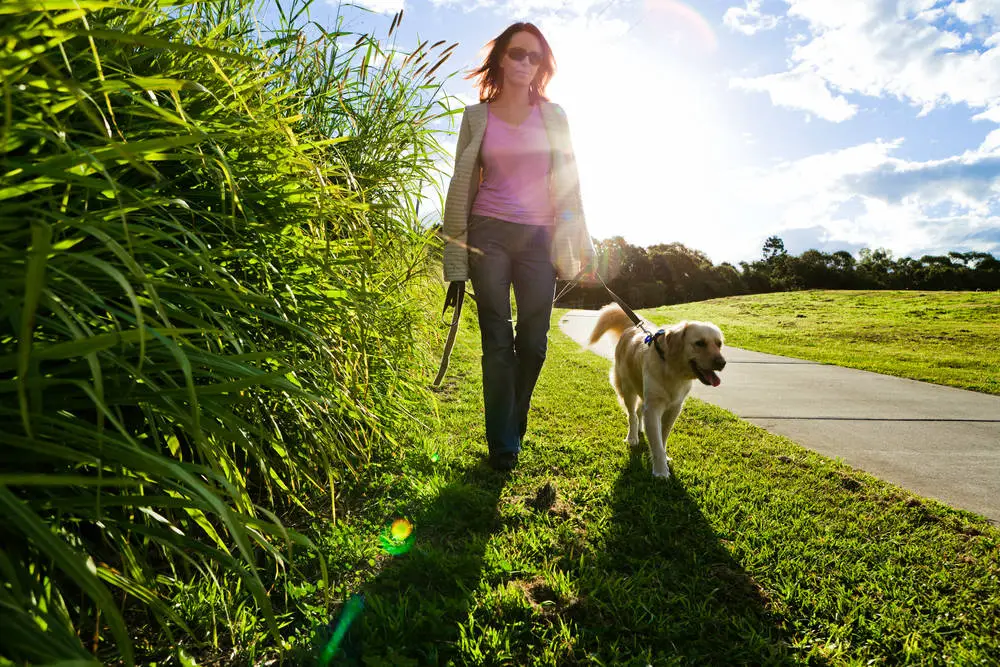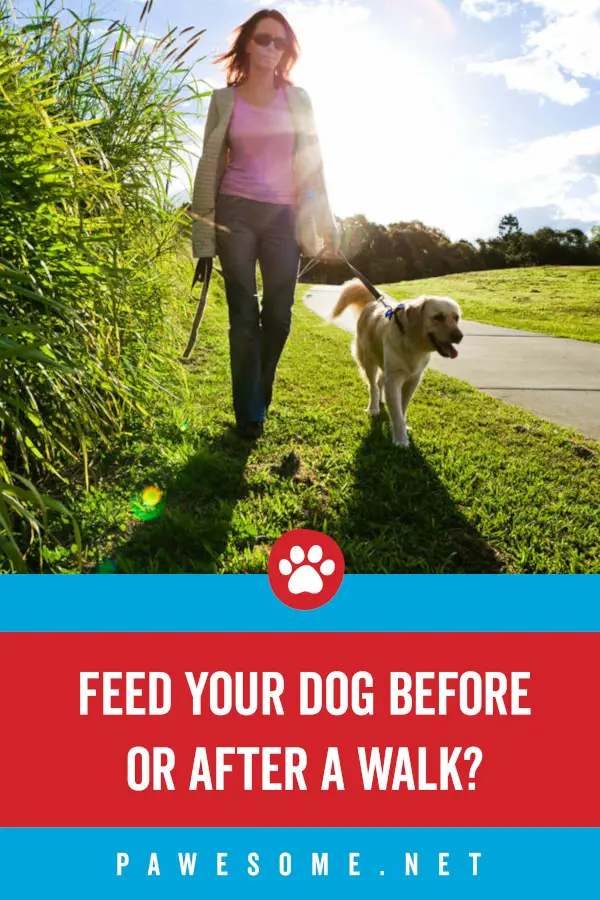
Walking your dog is an essential activity for two reasons. One is to give the canine a ‘potty break’. The other is to stimulate your pet physically, mentally and even socially as well as give it behavioral training. It is also a great way to bond with your pooch.
Should It Be Before or After a Meal?
This depends on what the walk is for. If your dog wants to relieve herself and it is just a gentle stroll till she reaches her favorite tree to answer nature’s call, it doesn’t matter whether you feed her before or after a meal. But if it is a little more strenuous and for a longer time than it takes to relieve herself and get back, then it is best if there is a gap between a meal and the walk, before and after.
For Nature’s Calls
The breed and age of your pet will matter here. For instance, if your pooch is a pup and you are still training her, then taking her for a walk soon after waking up and giving breakfast will set a daily ritual that will become a habit. If you maintain the time for this activity every day, it will help in regulating the dog’s bowel movement and keep her healthy and happy.
When the pup is very young, she may need to empty her bladder and poop soon after a meal. Be alert to the need and take her out not only to keep your carpet clean but also to establish the routine. Because they tend to eat more often than adult dogs, their need to clear their bowels is also a little more frequent. It is the same with liquids too, causing her to urinate more often.
But as she grows older, you can give a 5 to 30-minute gap before taking her out. Her meal requirement also reduces and she will take a longer time to digest food. Like adult humans, adult dogs too can hold their bladder for a few minutes before you take them out. Giving a gap will not cause any accidents and it will give her time to digest her food.
As an Exercise
When you intend for the walk to be an exercise, it needs a little more consideration. You should allocate at least 30 minutes for the walk and it needs to be more than just a leisurely saunter for it to have an impact. Taking a stroll with your pooch is healthy for her in many ways:
- It will help maintain body weight and prevent obesity which can lead to difficulties as your pet ages. Walking can burn the excess calories and keep her lean and mean, agile and active.
- Not only does being lightweight promote better joint health but by keeping the joints in motion, it will remain in good shape for a long time. It will delay the onset of arthritis and arthritic pain.
- By taking a regular walk, her digestive and urinary health will improve. The walk helps set a regular schedule, which is good for the bowels and prevents constipation. When she empties it frequently, she will be unlikely to be afflicted by bladder infections.
You may be letting your dog out into your garden when she has the urge and may think that is good enough. But a walk outside, away from home, is just as beneficial for the canine as getting away from the home is for you. It is a good diversion that will prevent your pooch from getting bored and becoming destructive as a result.
A regular walk is something that will become a part of her routine and something she looks forward to. It will be a mental stimulant as well as can channelize her excess energy, improving her sleep at night. It will also keep unwanted attention-seeking behavior at bay.
This is a great way to spend some quality time with your canine and give her the attention she needs. Some dogs start whining and barking too much just to get you to notice them and spend time with them.
While there is no denying the benefits, taking the dog on walks when she is on a full stomach or giving her meals immediately on return from a rigorous walk can be bad for her. It could lead to gastric dilatation-volvulus (GDV) that causes bloating and twisting of the stomach or gastric or gut torsion.
Related: Do Dogs Have Lips?
After-Meal Walk Risks
GDV is a condition common to deep-chested breeds such as the Greyhounds, German Shepherds and Labradors but is not confined to them and can occur in all dogs. So do be careful.
Some of the factors that can trigger this are anxiety, excitement, stress, rigorous training and large meals. Going for a walk as an exercise and then returning to a hearty meal is a potentially dangerous combination that can cause GDV.
If your pet is very hungry after all the brisk walking she has done, she is likely to gobble a large meal quickly, which can also trigger GDV.
GDV is not a mild gastritis kind of problem but something more severe and serious. Watch out for the following signs and symptoms:
- Your canine may be very excitable, stressed or anxious soon after a walk and a meal.
- She may have a bloated stomach due to gas getting accumulated in the stomach.
- She may struggle to empty her bowels, even whining in pain sometimes.
- She may be uncomfortable.
In the initial stages of this condition, her behavior may otherwise seem normal. Just by being with her when she is in discomfort, you can calm her down. At this stage, she may recover without doing much damage.
In the next phase, her stomach will start to dilate and twist, the anxiety and restlessness will be a little more pronounced and you may see her pacing and drooling. Her abdomen would be swollen and/or painful. Make sure you call, or better still, visit the vet, for checking her up. With something to release her stomach, she will be able to recover quickly.
When the condition worsens, the blood flow to her stomach stops, the twisting increases and she can go into shock. This will increase her restlessness, whining and panting. Excessive drooling will be accompanied by her standing with her legs spread and head hanging. You can see the gums turn dark red. She may need surgery to rectify her stomach and you may need to put your pet on a fluid drip.
As the condition progresses, the shock becomes severe and the canine’s intestines will get affected. There will be difficulty in standing and breathing, the abdomen will swell more and the gums will become pale. This is quite a critical condition. Though surgery may be performed, your pooch may not survive at this stage.
Yes, it is very painful and not a happy situation. Normally it is seen to occur within two hours of a meal. Exercising immediately after dinner is not such a great idea as even in the mild and earlier stages, your pet may find it very difficult.
In fact, vets recommend that you do not feed them large meals but space it out. Also, teach your pet to eat slowly. Providing enough water to drink and resting after a meal to allow the stomach to digest food slowly is better than leashing your dog and taking her out soon after eating.
The body needs to use its energies to digest food. When your dog is taken for a walk, the energy dissipates to burning calories and speeding up the digestion process as well.
Feeding Post-Walk
So we can infer from this that it is safer to take your pet for a walk before a meal. Should you give her a meal immediately on return? Our experts veto that too. If the walk has been brisk and truly stimulating, the body’s vitals are going to be high. The heart rate, blood pressure and the likes are going to be in a hyper state as also your pet herself, who may be excited from the work out.
This too causes a dysfunction in the sphincter, located between the esophagus and the stomach, and can have the same effect as eating immediately after a walk. The risk of GDV is just as high in such a situation too.
Do not panic. It is not every dog who goes through it. But it is better to be cautious and let your pet relax before and after a meal to let the digestive system do its job in peace. It would be ideal to provide a 45-minute to one-hour break between a meal and the walk, before or after.
Pacing the Meals
Pups may eat two to three meals a day but an adult can survive on just two. The little ones may need to go out immediately after a meal. In such a case, your yard may be good enough.
An adult may sometimes go off food for a day or longer and fast by skipping meals. This is perfectly fine so long as she is active and healthy. If anything, this gives the digestive system some rest.
However, if the dog has not been eating for some time, then go easy on the walk. Low glucose levels can bring down the energy and long walks can prove strenuous.
Observe your pet’s pattern of eating and answering nature’s call. Each dog has its own routine though you can help it by setting one from the time they are young. By setting a predictable routine, you help your pooch as well as can pace the meals and the walks such that there is no clash.
Keep a gap of 8-12 hours between breakfast and the next meal. Set a routine for a walk soon after waking up and again in the evening, 45 minutes to 1 hour before the meal.
Size of the Meal
Another thing to factor in when planning on a walk is the size of a meal. If your pet has only had a light snack, you can take her for a walk in 20-30 minutes. If the meal size was more substantial, giving a longer break is advisable.
You can take your pet for walks up to 20-30 minutes after giving the proper rest post-meal. If your dog is overweight, though, go a little easy as it can strain the heart. On returning from the walk, give just water and leave a gap till the next mealtime.
Normally, dogs tend to become overweight due to food being available at all times and not getting sufficient exercise to burn it off. It is best to have a strict schedule. You may be unable to resist those melting eyes that can make you feel guilty if you don’t share some tidbits now and then. Well, tidbits are okay, but strictly, nothing more.
Walk and Meal
Walking and meals are two critical aspects of your pet’s life but they don’t go well together. You can feed your dog before or after the meal, but leaving a gap is important. Walking immediately before or after a meal can trigger stomach discomfort to critical stomach twisting that can even prove fatal.
Have a strict schedule where you keep a gap of at least 45 minutes to an hour between the meal and the walk so that your pet can get good exercise and digest the food calmly. Pee breaks are fine but an exercise session of 20-30 minutes is best done on a light stomach.
We hope this article has given you clarity on when to feed your dog and how to better set up a routine for your dog based on the above findings. A lot of things will depend on different aspects specifically relevant to your dog, that we’ve addressed above. Happy dog walking!

